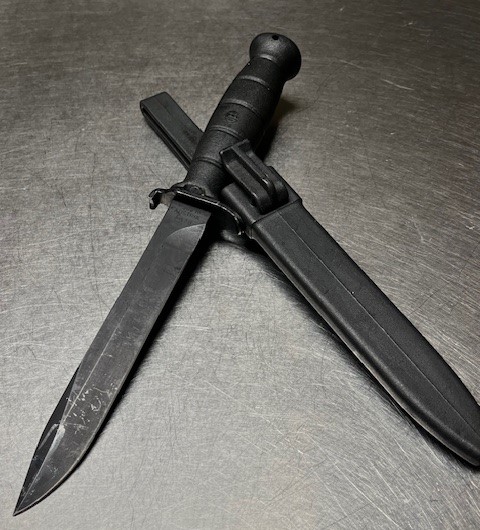Gaston Glock, founder of Glock Ges.m.b.H., died today at the age of 94.

His company got its start in 1963 making curtain rods and then field knives for the Austrian military. His purchase of an injection moulding machine to make handle handles for his field knives gave him the experience with injection molded polymer. He took that knowledge and applied it to making a polymer pistol for the Austrian army. He received a patent for it in 1981 and it became known as the Glock 17. The rest, as they say, is history.
In announcing his death, the company said:
Make it simple, make it perfect.
Following this guiding principle, our founder, Gaston Glock not only revolutionized the world of small arms in the 1980s, but also succeeded in establishing the GLOCK brand as the global leader in the handgun industry. His internationally renowned GLOCK Perfection stands for uncompromising quality and maximum customer satisfaction.Gaston Glock charted the strategic direction of the GLOCK Group throughout his life and prepared it for the future. His life’s work will continue in his spirit.
Unlike many, I’m not a Glock fan-boi. I do have a Gen 4 Glock 17 and a police trade-in Gen 2 Glock 22 but my collection contain many more Rugers, Smiths, and CZs. I have had one of those Glock field knives for much longer than I have had either pistol. Mine is marked FM 78 for Feldmesser 78 and you can see it in the picture below. It is a tough knife that doesn’t need to be babied.

The Glock 17 was neither the first polymer pistol nor the first striker fired pistol. Those accolades belong to the Heckler & Koch VP70 (1970) and the Hugo Borchardt C-93 (1883) respectively. What Mr. Glock did do was produce a simplified striker-fired polymer pistol which morphed to become the most popular brand of handgun for law enforcement and civilian alike. World wide sales of the various models of Glock pistols were estimated to be around $500 million annually in 2017. Undoubtedly, the figure is higher now in 2023.
I will not get into the details of Gaston Glock’s life. Needless to say, it has been interesting. While a little dated, the best book on his life and the growth of his company through 2012 is Paul Barrett’s Glock: The Rise of America’s Gun (commission earned). I bought my Kindle copy of it back in 2012 shortly after it was released. It makes for an interesting read.


RIP
I’ve never been a Glock fan, but they are like a Timex watch. They’ll seemingly run forever.
Personally, I don’t get the “fan boi” thing. I guess it’s just a difference in personality. Some people can’t enjoy something unless deciding that everything else of that type is crap and not worth considering.
At any rate, Glock handguns weren’t so successful because of the innovation of the design or aesthetic appeal or anything like that. Glocks are the Toyota Corolla of the gun world. They’re affordable, simple and dependable.
In short, they just work.
I’m not particularly a fan. I’ve got a Gen 3 Glock 19 that I bought dirt cheap because it was a Police trade-in. We actually bought it for my Wife, but she’s graduated to a Sig so I’ve been “playing” with the Glock (threaded barrel with compensator, ramped magazine well, RMR cut slide with a dot sight) and use it for shooting bowling pin and steel matches.
The thing is, as much as I don’t have any particular affinity for the gun (and I particularly don’t like the feel of the trigger), it just works. It’s accurate, it points well and the only malfunction I’ve ever experienced was a result of a poorly made aftermarket magazine.
I don’t think Gaston Glock revolutionized the gun world, or did anything groundbreaking in his design; what he did was make consistently high quality, dependable guns that are affordable for pretty much everyone.
He’s more akin to Henry Ford than Benjamin Henry. Both had a huge impact in their industry, but in different ways.
From my experience, those who come to the Glock with an open mind dislike them because of the size of the grip, or the grip angle. Now days, with the profusion of models and back straps, the size problem has almost disappeared. The genius of the GLOCK, and a huge part of its reliability, is its small number of parts. The entire Gen 3 Glock 17, including the magazine, has only 35 parts. There is simply less that CAN go wrong. For comparison, a 1911 A1 has 48 to 53 parts, an H&K USP has 51, and a Smith and Wesson M&P has 46. I’ve shot and carried them all, as well as SIGs, FNs, and revolvers, but these days I still prefer a Glock. The three biggest reasons any of these major brands have problems is poor shooting technique, lack of preventive maintenance, and aftermarket customization.
Ammo is a distant fourth. As I learned early on, “Any gun will do, if YOU will do.”
Five of my best friends:
Sam
John
Mikhail
Eugene
Gaston
May they all rest in peace.